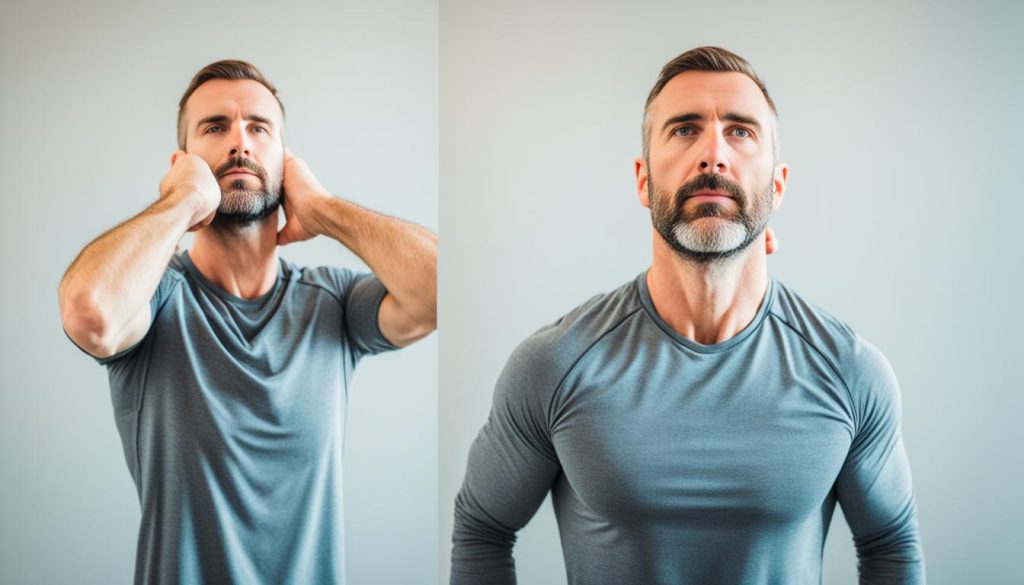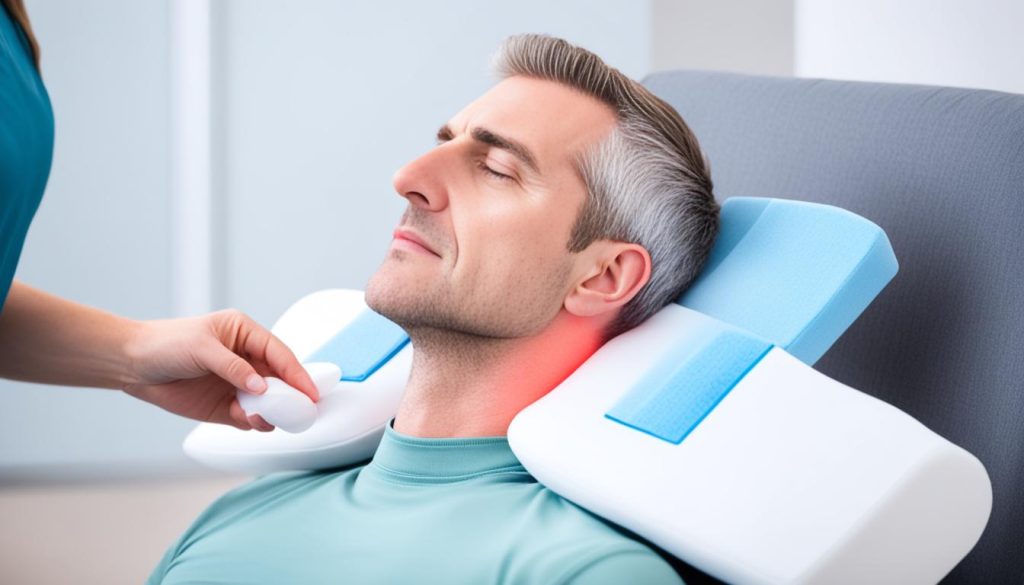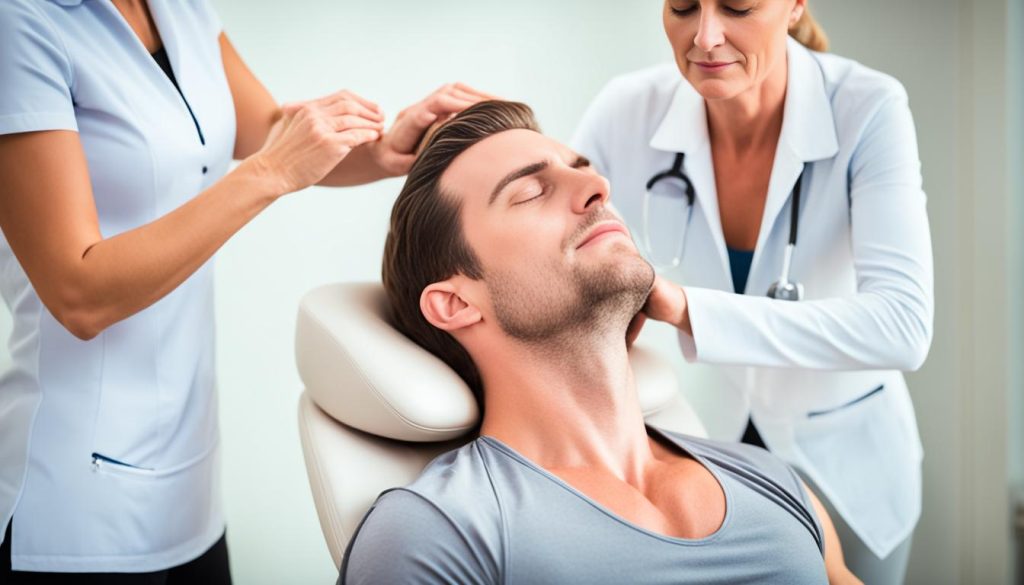Neck pain can be a real nuisance, affecting your daily activities and overall well-being. If you’ve ever experienced a kink in your neck, you know just how uncomfortable and limiting it can be. The good news is that there are effective ways to alleviate neck pain and get quick relief. In this article, we will explore various home remedies, exercises, stretches, and massage techniques that can help you find relief from that pesky neck kink.
How to Get Rid of a Kink in Your Neck?
When it comes to getting rid of a kink in your neck, it’s important to address the root cause of the problem. Neck pain can be caused by muscle strain, poor posture, or even stress. By incorporating neck exercises and stretches into your daily routine, you can strengthen your neck muscles and improve flexibility, which will help alleviate pain and prevent future kinks.
Additionally, hot and cold therapy can provide quick relief for neck pain. By applying ice packs and heating pads alternately, you can reduce inflammation and relax tense muscles in the neck. Over-the-counter medications like NSAIDs can also help reduce pain and inflammation during flare-ups.
Another crucial aspect to consider is your posture. Poor posture can contribute to neck pain and kinks. By making simple postural changes like maintaining a neutral head position and rolling your shoulders down and away from your ears, you can relieve strain on your neck and improve its overall health.
Lastly, incorporating regular neck massages into your routine can help loosen up stiff neck muscles and promote proper blood flow. By gently applying heat to the neck and using massage techniques directed towards the heart, you can enhance muscle relaxation and further reduce tension in the neck.
In conclusion, dealing with a kink in your neck can be a frustrating experience, but there are effective solutions available. By incorporating exercises, stretches, hot and cold therapy, posture changes, and regular massages, you can find relief from neck pain and prevent future kinks. Remember, if home remedies do not provide sufficient relief, it is always recommended to seek professional medical advice. Take control of your neck health and enjoy a pain-free life!
Move More to Reduce Neck Pain
Movement can actually help alleviate neck pain. Exercise improves blood flow to stiff muscles, reduces inflammation, and strengthens the neck muscles and joints. However, it is important to avoid jerking or sharp twisting movements that can exacerbate or cause neck pain.
When it comes to neck pain relief, incorporating regular neck exercises and stretches into your routine can make a significant difference. These exercises help to increase flexibility, reduce muscle tension, and improve posture, all of which contribute to overall neck health.
Here are some effective neck exercises and stretches to include in your daily routine:
1. Neck tilts
Sit or stand with your back straight. Slowly tilt your head towards your left shoulder and hold for 10-15 seconds. Repeat on the right side. Perform 2-3 sets on each side.
2. Chin tucks
Sit or stand with your back straight. Gently tuck your chin in towards your chest, creating a double chin. Hold for 10-15 seconds and release. Repeat 10-12 times.
3. Shoulder rolls
Relax your shoulders and roll them forward in a circular motion. Repeat 10-12 times and then roll them backward for the same number of repetitions.
Remember to perform these exercises and stretches in a slow and controlled manner, avoiding any sudden or jerky movements. If you experience any pain or discomfort while performing these exercises, stop immediately and consult with a healthcare professional.
In addition to exercises, it is important to incorporate regular breaks and movement into your day, especially if you have a sedentary job. Take short walks, stretch your neck and shoulders, and adjust your sitting position periodically to prevent muscle stiffness and tension.
By incorporating regular movement, exercises, and stretches into your daily routine, you can effectively reduce neck pain and promote better overall neck health.

Hot and cold therapy for quick relief
- Ice packs: Applying ice packs to your neck can provide relief by reducing inflammation. The cold temperature helps numb the area and reduce swelling in the neck muscles. Wrap an ice pack in a thin cloth and apply it to the affected area for about 15-20 minutes. Repeat this several times a day for optimal relief.

- Heating pads: Heat therapy is another effective way to relax stiff neck muscles. Use a heating pad or a warm towel warmed in the microwave and apply it to your neck for 15-20 minutes. The heat helps increase blood flow and relaxes the muscles, providing soothing relief from neck pain. Avoid using heating pads on high temperature settings to prevent burns.
- Alternating between hot and cold: To further maximize relief, you can alternate between cold and heat therapy. Begin with ice pack therapy for the first 15 minutes, then switch to a heating pad for the next 15 minutes. This combination of hot and cold therapy helps reduce pain, inflammation, and muscle tension in the neck.
Hot and cold therapy is a natural and effective remedy for neck pain relief. It is recommended to apply the therapy for about 20 minutes several times a day to experience optimal benefits. However, if your neck pain persists or worsens, it is advisable to consult a healthcare professional for further evaluation and treatment.
| Benefits of Hot and Cold Therapy for Neck Pain Relief | Hot Therapy | Cold Therapy |
|---|---|---|
| Reduces inflammation | Yes | Yes |
| Relaxes stiff neck muscles | Yes | No |
| Increases blood flow | Yes | No |
| Soothes neck pain and tension | Yes | Yes |
Over-the-counter Medications for Pain Relief
When it comes to finding relief from neck pain, over-the-counter medications can be a helpful solution. Nonsteroidal anti-inflammatory drugs (NSAIDs) like ibuprofen and naproxen can effectively reduce inflammation in the neck, providing relief from pain. Acetaminophen is another common over-the-counter medication that can alleviate neck pain by targeting pain receptors in the body.
However, it is important to take these medications as directed and follow the recommended dosage. Overusing or exceeding the recommended dosage can lead to adverse side effects and potential harm to your health. It is always best to consult with a healthcare provider before starting any new medication, especially if you have underlying health conditions or are taking other medications.
Over-the-counter medications can be a beneficial part of your neck pain relief strategy, but they should be used in conjunction with other natural remedies and lifestyle changes. It is important to address the root cause of your neck pain and make necessary adjustments to your daily routine, such as incorporating neck exercises and stretches, maintaining proper posture, and applying hot or cold therapy.
By combining over-the-counter medications with these natural remedies for neck pain, you can achieve long-lasting relief and improve your overall neck health.

Benefits of Over-the-Counter Medications for Neck Pain Relief:
- Reduces inflammation in the neck
- Alleviates pain associated with muscle strain or tension
- Provides quick relief
- Can be easily accessed without a prescription
- Can be used in conjunction with other natural remedies
Postural Changes to Improve Neck Health
Poor posture can contribute to neck pain. In today’s digital age, where people spend long hours hunched over screens and devices, it’s no wonder that neck pain has become increasingly common. However, making simple changes to your posture can help alleviate discomfort and promote neck pain relief.
An important aspect of improving neck health is maintaining proper head position. Try to keep your head in line with the center of your body, avoiding excessive tilting or forward protrusion. This helps distribute the weight of your head evenly and reduces strain on the neck muscles.
Another effective postural change is to roll your shoulders down and away from your ears. Many people tend to hunch their shoulders, which can lead to tension and pain in the neck area. By consciously relaxing and releasing tension in your shoulders, you can relieve strain on the neck muscles and promote better alignment.
In addition to these postural changes, incorporating neck exercises into your routine can further improve neck health. These exercises help strengthen the neck muscles, increase flexibility, and promote proper alignment. Some simple neck exercises include gentle neck stretches, head rotations, and shoulder shrugs.
It’s important to note that postural changes alone may not completely alleviate neck pain. If you’re experiencing persistent or severe neck pain, it is advisable to seek professional medical advice. A healthcare provider can assess your condition and recommend appropriate treatment options.
| Postural changes to improve neck health | Benefits |
|---|---|
| Maintain proper head position | – Distributes weight evenly – Reduces strain on neck muscles |
| Roll shoulders down and away from ears | – Relieves tension in the neck area – Promotes better alignment |
| Incorporate neck exercises | – Strengthens neck muscles – Increases flexibility – Promotes proper alignment |
Loosening Up Neck Muscles With Heat and Massage
When it comes to finding relief from neck pain, heat and massage can be incredibly beneficial. Applying gentle heat to the neck, whether it’s through a heating pad or a warm shower, can help loosen stiff neck muscles and alleviate discomfort. Heat helps to increase blood flow to the area, promoting relaxation and reducing muscle tension.
But the benefits don’t stop there. Following up with a gentle neck massage can further relax the muscles and promote proper blood flow. Neck massage techniques, such as kneading, circular motions, and gentle stretches, can help to release tension and improve flexibility in the neck. It’s important to direct the massage towards the heart to enhance circulation and enhance the neck’s range of motion.
Incorporating heat and massage into your neck pain relief routine can provide natural remedies for neck pain, allowing you to find comfort and relaxation. However, it’s crucial to listen to your body and not apply excessive pressure during the massage. If your neck pain persists or worsens, it’s recommended to consult with a healthcare professional for a comprehensive evaluation and treatment plan.

Benefits of Heat and Massage for Neck Pain Relief
Heat and massage offer several benefits for relieving neck pain:
- Increased blood circulation
- Reduced muscle tension
- Promotion of relaxation
- Improved flexibility
- Enhanced range of motion
- Decreased stiffness
Precautions
While heat and massage can provide relief for neck pain, it’s important to take certain precautions:
- Always use a towel or cloth between the heating pad and your skin to avoid burns.
- Apply heat for no longer than 20 minutes at a time to prevent skin sensitive and irritation.
- Be gentle during the massage and avoid applying excessive pressure.
- Avoid massaging areas that are swollen, bruised, or injured.
When to Seek Medical Attention
If your neck pain is severe, persistent, or accompanied by other concerning symptoms such as tingling and numbness, weakness, or difficulty moving your arms or legs, it’s important to seek medical attention. These symptoms may indicate a more serious underlying condition that requires further evaluation and treatment.
| Neck Pain Relief Techniques | Description |
|---|---|
| Heat therapy | Applying warm compresses, using a heating pad, or taking a warm shower to relax stiff neck muscles. |
| Massage therapy | Gentle manipulation of the neck muscles to release tension, improve circulation, and enhance flexibility. |
| Stretching exercises | Performing targeted stretches to improve range of motion and alleviate muscle stiffness in the neck. |
| Proper posture | Maintaining correct posture while sitting, standing, and sleeping to prevent strain on the neck. |
| Relaxation techniques | Practicing stress-reducing techniques such as deep breathing, meditation, or yoga to relax the mind and body. |
Releasing Tension in the Neck Through Stretching
Regular stretching can help provide relief from neck pain and release tension in the neck muscles. By incorporating simple neck stretches into your daily routine, you can alleviate stiffness and promote neck pain relief. Here are some effective neck stretches to try:
1. Head presses
To perform head presses, sit up straight with your shoulders relaxed. Slowly press your head forward, aiming to bring your chin towards your chest. Hold the position for 10-15 seconds, then return to the starting position. Repeat this stretch 3-5 times.
2. Head tilts
To perform head tilts, sit or stand with your back straight. Slowly tilt your head towards one shoulder, aiming to bring your ear closer to your shoulder without raising it. Hold the position for 10-15 seconds, then return to the starting position. Repeat on the other side. Perform 3-5 repetitions on each side.
3. Shoulder blade squeezes
Shoulder blade squeezes are great for relieving tension in the upper right back and neck. Sit up straight and gently squeeze your shoulder blades together, keeping your shoulders relaxed. Hold the squeeze for 5-10 seconds, then release. Repeat this exercise 5-10 times.
4. Shoulder rolls
Shoulder rolls help loosen up the neck and shoulder muscles. Sit or stand with your back straight and gently roll your shoulders forward in a circular motion. Complete 5-10 forward rolls, then reverse the direction and perform 5-10 backward rolls.
Remember to perform these stretches slowly and within your comfort level. If you experience any pain or discomfort, stop the stretch and consult with a healthcare professional.
Regularly incorporating these neck stretches into your routine can help improve flexibility, reduce muscle tension, and provide natural neck pain relief. Be consistent with your stretching practice and listen to your body’s needs. If your neck pain persists or worsens, it is important to seek medical advice.
Fastest ways to cure a stiff neck
When you’re dealing with a stiff neck, finding quick relief is essential. Here are some of the fastest and most effective methods to alleviate neck stiffness:
1. Stretching
Stretching is a simple yet highly effective way to relieve a stiff neck. Gentle neck stretches can help relax and loosen the muscles, reducing pain and increasing flexibility. Try incorporating these stretches into your daily routine:
- Chin tucks
- Ear to shoulder stretch
- Neck rotations
- Shoulder shrugs
2. Gentle heat
Applying heat to the affected area can help soothe tense muscles and promote relaxation. Try using a heating pad, warm towel, or warm shower to apply gentle heat to your neck. Remember to be careful not to overheat the area, and always use a barrier between the heat source and your skin to prevent burns.
3. Over-the-counter pain relievers
Over-the-counter pain relievers, such as ibuprofen or acetaminophen, can provide quick relief from neck pain and reduce inflammation. Make sure to follow the recommended dosage and consult with a healthcare professional if you have any underlying conditions or concerns.
While these methods can provide immediate relief, it’s important to address the underlying causes of your neck stiffness as well. Here are some additional tips to prevent long-term neck pain and stiffness:
4. Maintain a healthy weight
Excess weight puts added strain on your spine and neck muscles. By maintaining a healthy weight through proper nutrition and regular exercise, you can reduce the stress on your neck and prevent stiffness.
5. Regular exercise
Engaging in regular exercise helps maintain strong and flexible muscles, including those in your neck. Incorporate activities that promote neck strength and mobility, such as yoga or Pilates, into your fitness routine.
6. Manage stress
Stress can contribute to muscle tension and exacerbate neck pain. Explore stress management techniques like deep breathing, meditation, or engaging in hobbies to help relax your muscles and alleviate neck stiffness.
7. Quit smoking
Smoking reduces blood flow to the muscles and slows down the healing process. By quitting smoking, you can improve circulation and promote the overall health of your neck muscles.
By implementing these tips and incorporating quick relief methods into your routine, you can find relief from a stiff neck and prevent future episodes of discomfort. Remember to listen to your body and consult with a healthcare professional if your symptoms persist or worsen.
Common Causes and Conditions Associated With Neck Pain
Neck pain can be a result of various factors, including poor posture, stress, muscle tension, muscle strain, osteoarthritis, fibromyalgia, compressed or pinched nerve, disc degeneration, whiplash, spinal cord injury, or concussion. Additionally, high stress levels, anxiety, depression, and certain infections or medical conditions can contribute to neck pain.
Understanding the causes and conditions associated with neck pain is crucial in finding effective remedies. By addressing the root cause, individuals can alleviate neck pain and improve their overall well-being.
Some common causes and conditions related to neck pain include:
- Poor Posture: Sustaining incorrect head and neck positions while sitting, standing, or sleeping can strain the neck muscles and lead to pain.
- Stress: Emotional and psychological stress can cause tension in the neck and shoulder muscles, resulting in pain and discomfort.
- Muscle Tension: Excessive strain on the neck muscles, often due to poor ergonomics or prolonged periods of sitting or standing, can cause muscle tension and pain.
- Muscle Strain: Overexertion or sudden movements that strain the neck muscles, such as heavy lifting or sports-related activities, can lead to muscle strain and subsequent pain.
- Osteoarthritis: Degenerative changes in the neck joints and cartilage, commonly associated with aging, can cause neck pain, stiffness, and limited mobility.
- Fibromyalgia: A chronic disorder characterized by widespread musculoskeletal pain, fibromyalgia can manifest with neck pain as one of its symptoms.
- Compressed or Pinched Nerve: Pressure on the spinal nerves due to herniated discs, bone spurs, or spinal misalignment can lead to neck pain, radiating sensations, and numbness.
- Disc Degeneration: Wear and tear of the intervertebral discs in the neck can cause disc degeneration, leading to neck pain, reduced mobility, and potential nerve impingement.
- Whiplash: A sudden and forceful back-and-forth movement of the neck, commonly experienced during car accidents, can cause whiplash injuries and associated neck pain.
- Spinal Cord Injury: Trauma or damage to the spinal cord can result in neck pain, along with other neurological symptoms, depending on the level and extent of the injury.
Identifying the specific cause or condition underlying neck pain is essential in determining the most suitable remedies and treatment options.
Conclusion
Managing neck pain requires a comprehensive approach that includes home remedies, lifestyle changes, and professional treatment, if necessary. With neck pain relief and neck pain management, individuals can find relief and improve their overall neck health.
Addressing neck pain early is important to prevent it from becoming chronic. Home remedies such as exercises, hot and cold therapy, and over-the-counter medications can provide quick relief. Making postural changes and incorporating gentle heat and massage can also help alleviate neck pain.
However, if neck pain persists or worsens, it is recommended to seek professional treatment from a healthcare provider. They can provide a thorough evaluation, recommend targeted therapies, and develop a personalized plan for neck pain management to ensure long-term relief.




